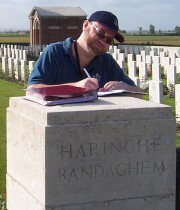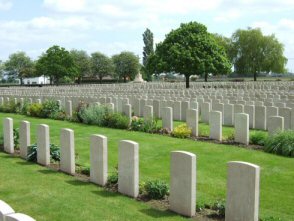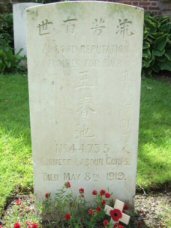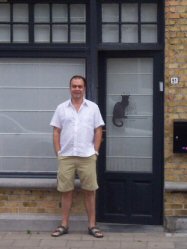![]() MARK GARDINER (with help
from Neil Mackenzie)
MARK GARDINER (with help
from Neil Mackenzie)
![]()
Day One - Saturday 19 May
This day comprised our outwards trip via the Tunnel and covered the cemeteries to the North-West and West of Ypres. I collected Neil about 4.30am and we were off for the Channel Tunnel. After managing the extraordinary feat of getting lost on the M25 (my fault!) we made our crossing and set out through France on a bright morning.
 |
Shortly after crossing the border into Belgium we made our first of many stops at Haringhe (Bandaghem) Military Cemetery, on the site of a casualty clearing station. It is a quiet place and like so many cemeteries on our trip, we were visiting it for the first time and found it was a beautiful site. The first resting place of the tour was that of Private Joseph Bulcock of the 9th Bn. Welsh Regiment, who suffered a gunshot wound to the head on 15 April 1918 & died 5 days later aged 39. Joe was a Burnley-born professional footballer who made appearances for Bury, Macclesfield, Exeter City, Crystal Palace & Swansea Town, and enlisted in December 1915. His age appears to be a matter of dispute with his military records indicating he was 5 years older than his footballing history suggests! |
Further down the road to Poperinghe was our next stop at another former casualty clearing station Mendinghem Military Cemetery to visit three soldiers: -
Private Albert Juniper of 7th Bn.Queen's Own (Royal West Kent Regiment) who lived at Kenley in Surrey & is commemorated on the Purley & Coulsdon War Memorial; he originally enlisted in the 2nd/5th (Cinque Ports) Bn. Royal Sussex Regiment in March 1916 and died of wounds on 15 October 1917 aged 23.
Private George Barrow of 6th Bn Oxfordshire & Buckinghamshire Light Infantry, who died of wounds on 31 August 1917.
Second Lieutenant Reginald Rees Jones of 1st Bn. Welsh Guards, who had been awarded the DSO for an action on the Yser Canal on 31 July 1917, the first day of Third Battle of Ypres / Passchendaele, where he suffered a mortal head wound, dying on 25 August 1917 aged 21. As subaltern in No.4 Coy. they attacked towards Wood 16; he rushed a pillbox - the battalion had not dealt with one before - and fired through the loophole killing the gunner while his men dealt with enemy as they left the pill box.
The flowers were just starting to bloom, and we got our first pungent smell of the agricultural countryside, providing proof we were back in Flanders!
We moved onto the small town of Watou to see the 12 graves at Watou Churchyard. These burials contain casualties over a four-year spread in two tiny sections, which led us to wonder why the later casualties had been buried there (and not at one of the larger casualty clearing station sites) or not removed at a later date. There were two particular soldiers we were visiting, both of whom were relatively unusual casualties: -
Second Lieutenant Robert Priest of 276th Bde. Royal Field Artillery, from Hull who had been promoted from the ranks (50th North Midland Brigade Royal Field Artillery Territorial Force) and died on 15 August 1917; his service record contains a hand-written remark that his death aged 22 was self-inflicted but there were no further details or comments regarding this.
Private Philip Dougherty of 11th Bn. The King's (Liverpool Regiment) who was accidentally killed during bombing instruction on 15 November 1915, aged 38; the courts martial held at Ypres Prison shared the blame between Private Hargreaves and Serjeant Tipton, although evidence suggests that both the battalion bombing officer and the C.O. were also responsible to some degree. He had enlisted in August 1914 and was the father of seven children
Our next port of call, St. Jan-ter-Bizen Communal Cemetery, proved to be one of the most difficult to find. With a lack of road signs and place names the turning was missed, and with the cemetery being tucked away behind some houses, it was only by luck that we found it on our fourth trip past it! There is only one British burial amongst the communal graves, Private Alfred Smith of the Gloucestershire Regiment who died on 30 April 1918 ; CWGC records state he was serving with 1st/5th Bn. but as they had been in Italy since November 1917 it is more likely that he was amongst reserves drafted to the 8th Bn. who were in the area. So far his service record has eluded us, and one wonders about the circumstances that led him to end up here on his own.
Onwards to Nine Elms British Cemetery which has good views of the Flanders' hills, and is another beautifully laid out cemetery on the site of casualty clearing stations, holding over 1,600 burials. We were visiting two soldiers: -
Private Geoffrey Chart of 4th Regiment South African Infantry who was wounded in action near Frezenburg and died two days later on 23 September 1917 aged 36. He was an old boy of Whitgift Grammar School in South Croydon who had served in the South African (Boer) War and apparently stayed out in Cape Town before enlisting at the outbreak of war, arriving in England in 1916.
Private Thomas Condry of 1st Bn. Cameronians (Scottish Rifles) who died of wounds on 22 January 1918 aged 22, whose family hailed from Accrington and is commemorated there.
Next was Abeele Aerodrome Military Cemetery just off the road between Poperinghe and Steenvorde, a matter of yards from the French border, and marked by a typically bored looking teenage girl standing with her bicycle smoking a cigarette and giving us suspicious looks. There is a large open space nearby which was the site of the aerodrome, from where some of our later casualties were based. Inside the small walled cemetery there apparently unused areas of grass which were where the US and French graves used to be. One is surprised to discover that there are over 100 still buried in what seems a small enclosed space. Again we were visiting two specific soldiers: -
Private David Elcombe of the Army Cyclist Corps attached to 60th (London) Division, who died on 30 April 1918 aged 19. He had enlisted in Kensington, London in 1915 aged 16 by stating he was 18 years 7 months old.
Captain William Hedley of 1st Bn. (formerly the 8th Bn.) The Buffs (East Kent Regiment), who died on 19 July 1918 aged 23. He had applied for a temporary commission in August 1914 and previously been mentioned in despatches, and there is some doubt about both his rank (records indicate he was either a Temporary Lieutenant or an Acting Captain) and whether he was killed outright or died of wounds. His father was the vicar at Nackington, near Canterbury, Kent.
We turned into France for our next two cemeteries, the only ones we were to visit outside Belgium during our trip. First was the rarely-visited (according to the visitors' book) Godewaersvelde British Cemetery which holds almost 1,000 burials on the site of a casualty clearing station. It has an unusual layout, partly due to the removal of a number of French graves, but the location is perfect with views of rolling countryside, and a large number of flowers, particularly yellow roses. The position is not perfect though, as the headstones are heavily weathered. There were two graves we were particularly visiting: -
Private William Wilson of 21st Field Ambulance, Royal Army Medical Corps who died on 11 October 1917; his family came from Accrington, where he is commemorated, and his wife lived in nearby Great Harwood.
Sister Elise Margaret Kemp of the Territorial Force Nursing Service (58th CCS), the only lady on our list. Born in 1882 in Wellington, New Zealand the daughter of a surgeon (William George Kemp) and his wife Charlotte; the family were living in West Dulwich at time of 1901 census and she trained at Kings College Hospital. Although part of 58th CCS she was doing temporary duty with 37th CCS at time of death during a air raid on 20 October 1917. The matron report from 4th London General Hospital said "a very good ward sister excellent disciplinarian and very capable. Has had good experience in administrative work, suitable for further promotion at home and abroad." A letter from Miss Ray (Principal Matron, 4th London Gen Hospital, Denmark Hill) dated 23 October 1917 said "it was with very great sorrow that we heard of the death of our dear sister Elise this morning. She was an excellent nurse and a most beautiful character and has left a fine example to others." A letter was sent to her father from the Advisory Council of TFNS expressing their sorrow to which he replied "…..Her heart was so thoroughly in her work that I was sure she would not fail under pressure." There is a memorial window in the chapel at Kings College Hospital (near Denmark Hill tube) to this lady.
Next came Bertenacre Military Cemetery in a very isolated spot by the side of the A25 set in a sea of corn. There are 38 men of the 10th Bn. Queen's (Royal West Surrey Regiment) buried here who were killed by an air raid on their camp near Thieushouck on 18 August 1917; the cemetery affords views of both the site of this camp and their original burial place, The Royal West Surrey Cemetery, Fletre. We were visiting the resting place of Lieutenant Thomas Kavanagh of 3rd Bn. Royal Irish Fusiliers, who was killed on 24 August 1918 aged 26 whilst attached to the 1st Bn. (although his service record indicates he was with the 9th Inniskillings when he was killed). He was married but this had been kept secret from his family in Ireland and he had been previously hospitalised after a gas attack.; personal effects included the medal ribbon for a MM but there is no record of such an award to him that we could find. The war diary for 1st Bn. Royal Irish Fusiliers for 24 April 1918 details a successful attack on a German trench at Tomlin Farm on the Bailleul - Mont Noir Road at the cost of 2 officers and 7 other ranks killed; presumably Second Lieutenant Bunting in the next grave was the other officer killed.
We returned to Belgium to a cemetery we had visited on several previous occasions, Lijssenthoek Military Cemetery where there are over 10,750 Commonwealth burials at the site of various casualty clearing stations.

We also bumped into what we assumed would be the first of many tour coaches, this one from Stevenage. We were visiting four particular soldiers: -
Private Arthur Hooper of 8th Bn. King's Own (Royal Lancaster Regiment), a professional footballer who played for Manchester United and Crystal Palace, and died of wounds on 4 April 1916.
Rifleman Charles Clements of 8th Bn. London Regiment (Post Office Rifles) who died on 12 June 1917 and is commemorated locally on both the Purley & Coulsdon and Coulsdon war memorials.
And two who served togther: -
Major Frederick Tubb VC and Company Serjeant Major John Schwarer of 7th Bn. Australian Infantry. Both had served at Gallipoli, and Tubb had won his VC (along with two other men) at Lone Pine on 9 August 1915. Both were severely wounded by British shells (now believed to be rounds fired by Australian artillery) falling short at Black Watch corner on 20 September 1917; Tubb died that day and Schwarer early the following morning, and they are buried in adjacent rows.
Following a brief lunch in Poperinghe we moved onto our final destinations, consisting of six cemeteries in two closely-grouped locations. First was Poperinghe Communal Cemetery which was the usual depressing French / Belgian Catholic graveyard with black and grey tombs, and lots of shale with no grass on the CWGC plots. We were visiting two victims of the First Battle of Ypres:-
Captain John Frederick Strathearn Gordon of the Cameronians (Scottish Rifles) attached to 1st Bn. Royal Scots Fusiliers. The son of a general, he had served in the South African War as well as seeing pre-war service in Somaliland and Nigeria. He was killed on 19 November 1914 whilst his unit was in the vicinity of Hooge.
Corporal Herbert Barrett of 2nd Bn. Worcestershire Regiment who was a regular soldier having enlisted in 1904 and seen postings in Colombo, Ceylon as a bandsman. His medical history is interesting, having contracted gonorrhoea and malaria which resulted in lengthy spells in hospital, as well as a contused head wound due to "direct violence." Promoted to corporal on 8 August 1914 he died of wounds on 21 October 1914 following action at Wallemglem.
Next was Poperinghe Old Military Cemetery set behind houses where the 450 graves are all jammed together at the back of the cemetery, leaving a large expanse of grass at the front where 1,300 French & Belgian - both military & civilian- casualties were originally buried before being later removed. This was one of our busiest cemeteries as we visited several casualties of the Second Battle of Ypres: -
Private John Hearne of 1st Bn. Royal Irish Regiment enlisted at Waterford in August 1914 aged 20 and landed in France in December 1914. He was wounded in action at Fortuin / St. Julien on 24 April 1915 and died the following day.
Private Mathew William Marquis of 2nd Bn. East Yorkshire Regiment who was probably wounded in a counter-attack at St. Jean on 23 April 1915 and died the following day.
Second Lieutenant James Fraser Glass of 2nd Bn. Seaforth Highlanders, who took part in the retreat from Mons and was wounded in October 1914; following recuperative home leave he returned to duty and died of wounds at No.3 CCS, Poperinghe, on 26 April 1915 aged 23. His battalion had been in action at Kitchener's Wood.
Captain Alexander Findlater Todd of 1st Bn. Norfolk Regiment who was related to a London firm of wine merchants, had been capped for England at rugby in 1896 and served in the South African War. He was shot through the neck whilst in the trenches near Hill 60 on 18 April 1915 (the day after returning from leave), and died of his wounds on 21 April 1915.
| Labourer Chin Chih Wang of 107th Coy. Chinese Labour Corps, who died on 6 May 1919, presumably a casualty of either battlefield clearance of Spanish Influenza. |  |
Poperinghe New Military Cemetery is a well laid out open cemetery at the side of the road, with a large section of French war graves on one side. There were some Belgian graves as well, one of which intrigued us: that of Martha Declercq. We were visiting the grave of Private Herbert Morris of 6th Bn. British West Indies Regiment, who was a black volunteer involved in the supply of artillery shells. Morris was charged with deserting his unit at Essex Farm on 20 August 1917 and during his courts martial in September he was undefended, and his own defence was a statement that ""I am troubled with my head & cannot stand the sound of guns. I reported to the Dr. & he gave me no medicine or anything. It was on Sunday 19.8.17 that I saw the doctor. He gave me no satisfaction." Despite the failure of his Medical Officer to appear, and testaments to his previous good behaviour, he was sentenced to be shot at dawn, partly as he had already served field punishment for a virtually identical offence that July, and was executed at Poperinghe Town Hall at 06:10 on 20 September 1917 aged 17.
Onto the cluster of burial grounds around Brandhoek, the first of which was Brandhoek Military Cemetery. Eerily we came across the final resting places of a Mackenzie and a Gardiner in neighbouring graves in this regular, neat cemetery. We were visiting the resting place of Second Lieutenant Henry Bradshaw of 74th Field Coy. Royal Engineers, who came from Clayton-le-Moors and is commemorated on the Accrington War Memorial. He was killed in action on 22 July 1917 aged 29.
Brandhoek New Military Cemetery is best known for being the final resting place of Captain Noel Chavasse VC & Bar, and his grave was marked by a forest of wooden crosses. Given the small area of this cemetery, it is surprising to find that there are 558 burials. We were specifically visiting Second Lieutenant Frank Roberson of 7th Bn. Queen's (Royal West Surrey) Regiment who hailed from Purley, but is not commemorated on the local war memorials to our knowledge. He had enlisted into the Honourable Artillery Company in 1915 and gained his commission on December 1916. He suffered shrapnel wounds to his abdomen during an attack at Inverness Copse on 10 August 1917, and died of his wounds at 44th CCS on 12 August 1917.
Our final stop was at Brandhoek New Military Cemetery No.3 where the headstones in exposed positions were heavily weathered; there are just short of 1,000 burials at this former Casualty Clearing Station site. We visited: -
Gunner John Walsh of "B" Battery, 245th Bde. Royal Field Artillery who died on 25 April 1918 and is commemorated on the Accrington War Memorial.
Second Lieutenant Maurice Gliddon MC of "B" Battery, 108th Bde. Royal Field Artillery who attended Whitgift Grammar School 1904-09 and lived in Caterham. He enlisted in the Honourable Artillery Company in September 1914 and gained his commission in the R.F.A. in November 1914, arriving in France in August 1915. Awarded the MC "for conspicuous gallantry and devotion to duty. He set a magnificent example to his men" in April 1917. At the time of his death he was Acting Captain and in command of the battery. The war diary strangely does not mention when he was wounded but the battery were heavily involved in bringing ammunition up the Potijze Road; he died of wounds on 16 August 1917.
Then it was on to Ypres after 11½ hours and 170 miles. We dropped off the car before heading to Sante for a few well deserved beers and to watch the FA Cup final. We had to leave after full time so missed the Chelsea winner in extra time.
 |
We met up with Alain and Carolyne who run the excellent Le Chat
Noir in Diksmuidsestraat on the north side of the Grote Markt. Although self
catering Alain and Carolyne can also provide breakfast if required and stop
by each day to clean and tidy. The place has been modernised and is very
comfortable with an attractive walled garden although, as with most houses
of its type in Ypres, the stairs are quite steep for the less sure footed.
Alain is a Chief Inspector in the local constabulary so you are in safe hands.
We also met Ross and Annie from Australia who were sharing the house for
one night.
|
After attending the Last Post we retired to Vivaldi's for some much needed food and drink and got to bed early after a long day.
![]()
 Copyright © Mark Gardiner,
March, 2008
Copyright © Mark Gardiner,
March, 2008
Return to the Contents Section